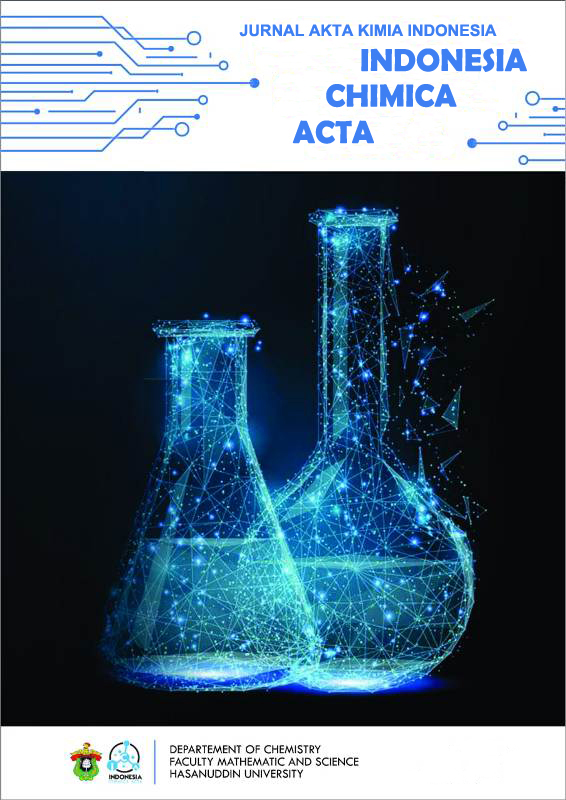Thermophilic Xylanase Production Rom Isolates of Macula’ Hot Springs Bacteria Using Corn Cobs Waste Media
Abstract
Full text article
References
Budiman, A., and Setyawan, S., 2013, Effect of Substrate Concentration, Incubation Length and Ph in the Process of Isolating Xylanase Enzymes Using Rice Straw Media, Chemical Engineering Department, Faculty of Engineering, Diponegoro University.
Cappucino, J.G., 1983, Microbiology: A Laboratory Manual, Addison Wesley, Publishing Company.
Djide, M.N., and Sartini, 2006, Basic Pharmaceutical Microbiology, Hasanuddin University, Makassar.
Habibie, F.M., Wardani, A.K., and Nurcholis, M., 2014, Isolation and Identification of Molecular Xylanase-Producing Thermophilic Microorganisms from Lapindo Hot Mud, Food Journal and Agroindustry, 2 (4): 231-238.
Lay, W., 1994, Microbial Analysis in Laboratories, PT. Raja Grafindo Persada, Jakarta.
Nakamura, S., Wakabayashi, K., Nakai, R., Aono, R., and Horikoshi, K., 1993, Purification and Some Properties of Alkaline Xylanase from Alkaliphilic Bacillus sp. Strains 41M-1, Applied and Environmental Microbiology, 59 (7): 2311-2316.
Natsir, H., Patong, A.R., Suhartono, M.T. and Ahmad A., 2010, Production and Characterization of Chitinase Enzymes from Hot Spring in South Sulawesi, Bacillus sp. HSA3-1a, Indo. Journal. of Chem, 10 (2): 256–260.
Natsir, H., Patong, A.R., Suhartono, M.T. and Ahmad, A. 2013. Isolation and Purification of Thermostable Chitinase Bacillus licheniformis Strain HSA3-1a From Sulili Hot Springs in South Sulawesi, Indonesia, Int. Journal of Pharm. Bio Sciences, 4 (3): 1252–1259.
Palaniswamy, M., Arulanandham, TV, and Angayaranni, J., 2012, Production of Xylanase by Litter Degrading Fungal Species Using Agro-Industrial Wastes as Substrates by Solid State Fermentation, Research Journal of Pharmaceutical, Biological and Chemical Sciences, 3 (1 ): 143-149.
Patong, A.R., 2013, Food Chemistry Analysis, Dua Satu Press, Makassar.
Poedjadi, A., 2012, Basics of Biochemistry, UI-Press, Jakarta.
Prayitno, D.A., and Rachmawaty, R., 2011, Use of Enzymes in the Food Industry, Paper Enzyme Technology, Chemical Engineering FT Diponegoro University, Semarang.
Prima, R.E., 2012, Production and Characterization of Xylanase Coarse Extract from Acinetobacter baumanii M-13.2A, Thesis, published, Faculty of Mathematics and Natural Sciences, Department of Biology, University of Indonesia.
Richana, N., 2002, Production and Prospects of Xylanase Enzymes in Bioindustry Development in Indonesia, Agro Bio Bulletin, 5 (1): 29-36.
Richana, N., and Lestina, P., 2003, Xylanase Production for Bioconversion of Soybean Seed Waste, Center for Biotechnology Research and Agricultural Genetic Resources.
Richana, N., Irawadi T.T, Nur M.A., Syamsu K., and Arkenan, Y., 2007, Xilan Extraction from Corn Cobs, Postharvest Journal, 4 (1): 38-43.
Richana, N., Irawadi T.T, Nur M.A., and Syamsu K., 2008, Isolation of Identification of Xylanase Producing Bacteria and Characterization of Enzymes, Journal of Agro Biogen, 4 (1): 24-34.
Septiningrum, K., and Apriana, C., 2011, Xylanase Production from Corn Cob with Bioprocess System Using Bacillus circulans for Pre-Bleaching Pulp, Journal of Industrial Research, 5 (1): 87-97.
Setyawati, I., 2006, Production and Characterization of Microbial Xylanase Isolated from Corn Cobs, Thesis, unpublished, Faculty of Agricultural Technology, Bogor Agricultural University.
Sopandi, T., and Wardah, 2013, Food Microbiology, Andi Yogyakarta, Yogyakarta.
Susilowati, PE, Raharjo S., Kurniawati D., Rahim R., Sumarlin, and Ardiansyah, 2012, Xylanase Production from Sonai Hot Springs Isolate, Southeast Sulawesi, using Agricultural Waste, Indonesian Naturals Journal, 14 (3): 199- 204.
Thoyib, H., Setyaningsih R., and Suranto, 2007, Selection and Identification of Xylanase-producing Alkaliphilic Bacteria from Bukit Krakitan, Biotechnology, 4 (1): 6-12.
Trismilah and Waltam D.S., 2009, Xylanase Production Using Media for Agriculture and Plantation Waste, Journal of Environmental Technology, 10 (2): 137-144.
Authors
This is an open access journal which means that all contents is freely available without charge to the user or his/her institution. Users are allowed to read, download, copy, distribute, print, search, or link to the full texts of the articles in this journal without asking prior permission from the publisher or the author.
Jurnal Akta Kimia Indonesia (Indonesia Chimica Acta) operates a CC BY-SA 4.0 © license for journal papers. Copyright remains with the author, but Jurnal Akta Kimia Indonesia (Indonesia Chimica Acta) is licensed to publish the paper, and the author agrees to make the article available with the CC BY-SA 4.0 license. Reproduction as another journal article in whole or in part would be plagiarism. Jurnal Akta Kimia Indonesia (Indonesia Chimica Acta) reserves all rights except those granted in this copyright notice.

